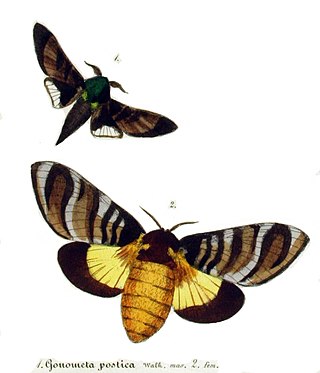
Colophospermum mopane, commonly called mopane, mopani, balsam tree, butterfly tree, or turpentine tree, is a tree in the legume family (Fabaceae), that grows in hot, dry, low-lying areas, 200 to 1,150 metres in elevation, in the far northern parts of Southern Africa. The tree only occurs in Africa and is the only species in genus Colophospermum. Its distinctive butterfly-shaped (bifoliate) leaf and thin seed pod make it easy to identify. In terms of human use it is, together with camel thorn and leadwood, one of the three regionally important firewood trees.
Argophara is a genus of moth in the family Gelechiidae. It contains the species Argophara epaxia, which is found in Namibia.
Euryctista is a genus of moths in the family Gelechiidae. It contains the species Euryctista hobohmi, which is found in Namibia and South Africa.
Grandipalpa is a genus of moths in the family Gelechiidae. It contains the species Grandipalpa robusta, which is found in Namibia.
Leucophylla is a genus of moth in the family Gelechiidae. It contains the species Leucophylla nigribasis, which is found in Namibia and South Africa.
Neopatetris is a genus of moths in the family Gelechiidae. It contains the species Neopatetris tenuis, which is found in Namibia and South Africa.
Schistovalva is a genus of moths in the family Gelechiidae. It contains the species Schistovalva trachyptera, which is found in Namibia.

Brephidium is a genus of butterflies in the family Lycaenidae. They are known commonly as pygmy blues. The species of this genus have a disjunct distribution. Two of the three species are found in the Americas while the third is found in Africa.
Meneclia is a monotypic moth genus in the subfamily Arctiinae. Its single species, Meneclia pallidula, is found in Namibia. Both the genus and species were first described by Karl Grünberg in 1910.
Tineomigma is a genus of moths belonging to the family Tineidae.
Stigmella perplexa is a moth of the genus Stigmella and the family Nepticulidae. It was described by Anthonie Johannes Theodorus Janse in 1948. This species of moth is found in Namibia.
Canalibotys is a genus of moths of the family Crambidae. It contains only one species, Canalibotys linealis, which is found in Namibia.
Daunabotys is a genus of moths of the family Crambidae. It contains only one species, Daunabotys bipunctalis, which is found in Namibia.
Ancylosis glaphyria is a species of snout moth in the genus Ancylosis. It was described by Boris Balinsky in 1987 and is known from South Africa and Namibia.
Ancylosis interjectella is a species of snout moth in the genus Ancylosis. It was described by Émile Louis Ragonot in 1888, and is known from South Africa and Namibia.
Ancylosis ocellella is a species of snout moth in the genus Ancylosis. It was described by Ragonot, in 1901, and is known from South Africa and Namibia.
Ancylosis subpyrethrella is a species of snout moth in the genus Ancylosis. It was described by Ragonot in 1888, and is known from Namibia and South Africa.
Delopterus is a monotypic snout moth genus. Its single species, Delopterus basalis, is found in Namibia, South Africa and Zimbabwe. Both the genus and species were first described by Anthonie Johannes Theodorus Janse in 1922.

Gonometa postica, known commonly as the African wild silk moth, burn worm, and brandwurm, is a large species of African moth belonging to the family Lasiocampidae. The genus Gonometa boasts some very large moths and larvae; Gonometa sjostedti from Africa has a larva 16 centimeters long, for example. Most of the Lasiocampidae are highly sexually dimorphic. In G. postica the forewing of the male measures 21–25 mm and of the female 35–42 mm.

Kewa is a genus of flowering plants, consisting of eight species of succulent sub-woody plants, native to eastern and southern Africa, including Saint Helena and Madagascar. These are small shrubs or herbs that form cushions and have edible, acid-tasting leaves. Kewa is the only genus in the family Kewaceae.



